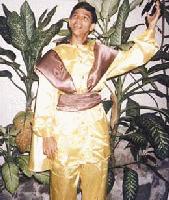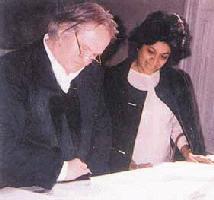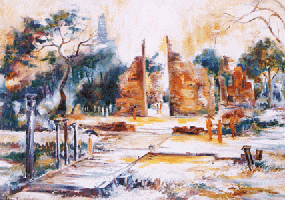




Khalid the Dreamer a production by the Asian International School will be staged at the Lionel Wendt Theatre on June 4 and 5.
This is the tale of a handsome, poor young man whose dreams of dwarfs in his beautifully laid out garden turn out to be reality.
The dwarfs with the assistance of Khalid recover their valuable diamond and reward him with a magical conch shell which produces wonderful music. The music has such unusual properties that beautiful Princess Zayda is bowled over by Khalid much to the annoyance of her suitor "King of the Forest".
 Andre
David in Khaled the Dreamer
Andre
David in Khaled the Dreamer
The play is directed by Samantha Abeywira
de Soysa who has done a number of successful shows in the footsteps of her
mother Yolande. Soundarie David handles the music. AIS has harnessed the best
in the field of Production/Direction for their play and have Indu Dharmasena
for their technical management and lights.
The cast includes: Andre David - Khalid; Shirabdi de Silva - Khalid’s mother; Shareika Medonza - Princess Zayda; Nicole Parakrama, Tahire Edirisinghe, Madushka Dharmapala - Friends; Emade Bakshy - The King; Thaneesha, Rukaiya, Farhana, Deepa, Ashna, Sabrina - Khalid’s sisters; Mathew, Anout, David, Anushu, Preshanthan, Imran, Robert - Dwarfs; Nuwan - King of the Forest ; Jeggan - Hassan Ali; Michael - Emir Cassim and Chantal Rosairo - Songstress.
Marie Alles Fernando celebrates thirty years of painting this week with an exhibition titled "Light and Colour" open to the public from June 6 to 9 from 10 a.m. to 8 p.m. each day at the Lionel Wendt. The official opening is on June 5.

 Left- Marie
Alles with Prof. Lehmden at the Master Class, Vienna Academy of Fine Arts, some
years ago, Right- Anuradhapura: Marie's vision
Left- Marie
Alles with Prof. Lehmden at the Master Class, Vienna Academy of Fine Arts, some
years ago, Right- Anuradhapura: Marie's vision
Marie Alles Fernando we feature here, not so much for the
fact that since the age of fifteen after her O/Levels she began painting,
starting with Douglas Amarasekera but because of her unusual sensitiveness to
nature and her rapport with the subjects in each scenic work.
She is not one of the run-of-the mill painters, but has a style of her own which compels an onlooker to keep studying her paintings. It is not only realism of expression, well chosen colour combinations but an acute responsiveness to the moods of the persons she paints.
A painting titled "Spirit of the Earth" depicting a village scene has all the delightful little cameo-like figures of village personalities, a carter resting on the side of his cart, a stubborn bull giving his master a hard time, women washing clothes obviously gossiping, and others carrying their baskets of fruits and vegetables, all captured in detail, to give the onlooker a picture of village life.
The lonely flute player at Kandalama leaning against a tree with a knee high cloth and bare bodied is unusual, yet captures the loneliness of the man playing music perhaps with only his thoughts for company.
"Freedom" is the painting depicting giant butterflies in shocking colours flying away into the sky. It is a colourful work.
Marie has caught the spirituality and that sense of reverence of the Vesthagiri caves at Anuradhapura with a temple perched high and isolated. This painting titled ‘In Search of Nirvana’ has caught the quietness and reverential attitudes of those making their way, in search of spiritual solace.
"Oriental Bazaar" is the title of a work that depicts the gaiety and brightness of a market place with wares displayed under a huge tree. One could sense here the happy haggling that goes on at such a bazaar.
A cave painted at Hambantota shows the skill of the painter in showing light and colour to make a beautiful setting.
"The Prayer of the Forest" Marie has titled appropriately a painting serenely calm, bathed in purple and blue patches which bring out the stillness of the forest.
Marie Alles Fernando has painted for thirty years. That is a long time. But what we want to stress is that her paintings portraying local people and scenes in deliciously good taste is a compliment to our country. Through her paintings she pays homage to the beauty of the people and the country.
Marie Alles Fernando has the gift to make her paintings stay alive to the onlooker.
The exhibition is in aid of the children’s heart project of the Inner Wheel Club of Colombo West of which she is a member.
ANZ Grindlays Bank and Cyril Fernando, her husband are responsible for organising this exhibition.
Values Education by Rev. Dr. Br. Baptist Croos FSC Co-Director, ISFA, Director, Lassallian English Academy Colombo Sri Lanka.
A tastefully designed volume - Values Education comes as a rare gift to the modern world, replete with degenerating standards.
The book advocates a positive approach to life.
Dr. Baptist Croos makes a sincere effort to teach the beautiful things in life (especially to young adults) by means of a collection of verse and prose. With a tinge of nostalgia Values Education makes one acknowledge a fusion of events in life that have often gone unappreciated.
Dr. Croos’ collection of entrancing anecdotes (some of them his own) justify the cause- "Example is better than precept." The collection of verses and essays presented in an easy and assured manner proclaim the writer’s intimation clearly- "Only quality people can produce quality goods."The book leads us through time and space, communities and lifestyles and at the end of the trip one feels like having learnt the world and the purpose of our existence. It focuses on life’s simplest beautiful moments and the abundance of gifts we are bestowed with which is seldom appreciated and so often taken for granted."God has blessed each one of us with so many qualities and abilities, only we must take the initiative to discover these values and put them into practice," says the preface.
A keen observation of men and manners unfolds in the pages. The text in itself is a unique experience. It is a book to be read over and over again in order to be able to discover many beautiful things we have missed out and are missing out in our day to day existence, love, peace, friendship et al
On reading ‘Only One Mother’ and ‘Maria Touched My Heart’ one cannot help a tear drop rolling.
Of course, there is humour and wit too in its pages.
The combination of simplicity of language with subtlety of comments and the many tips it offers to face myriad situations in life make reading compelling. The aptly presented exercises and quizzes found inbetween articles are truly mind teasing, though a trifle bewildering- a lesson in psychology. By hinting on subjects ranging from love, life, education, fidelity etc the book sets out the ‘right’ attitude towards life.
This should be compulsory reading at schools as lessons in guidance as it is imperative that students reflect on such thoughts and be motivated in the correct path with positive mind-set. Its serious messages aside, the treasure of contents is worth keeping.
Ashley Halpe has turned his many fine talents to direct an Australasian comedy...and the very entertaining 2 1/2-hour presentation of Ernest MacIntyre’s "Let’s Give Them Curry" raised chortles and titters and even some unrestrained guffaws at the Pushpadana Girls’ College Hall on May 18 and 19.
Enjoyable fare, to be sure, even though the straight-backed chair did nothing for my spine and the acoustics made every word ring in one’s ears. It was Ernest MacIntyre, surely, and one could rely on brisk repartee, lively cross talk and cool cucumbers in sarongs which is what Asia’s experience of Australia is all about.
Trust Ernest to see the funny side of the multi-cultural experience, especially when there is a wholly- explosive father (Hector Perera played convincingly by Arjuna Karalegama), and a more enlightened mother (Violet Perera played by Lalitha Gunawardena).
Indeed, Lalitha stole the show with some superb acting which the audience immediately related to. Here was the much-tried mother, putting up through the years with her husband’s peccadilloes, trying to hold the home together in circumstances that would try the patience of a Tartar on a spiked pole.
Her expressions, her mannerisms, her very body language, her brisk, impatient manner and her eyes that beseeched unseen gods so expressively to tell of the martyrdom of her being, were so marvellously natural that the audience could be sure of her many spasms of disdain, disapproval, and disinclination to be dragged into any of her husband’s convoluted schemes.
Husband Arjuna, despite all Bridget Halpe’s artful make-up, was a bit of a caricature: a young man with put-on mutton chops and chalk dusting and no age lines to speak of. Rather nadagam-ish. Pity about that, for so ill-matched a couple would be the butt of society whether in Sydney or Siyambalapitiya.
Three acts...the first, opening in a set-the-pace style, spoiled somewhat by the appearance of daughter Ranjini (played by Vinitha Samarasinghe) who is a key figure in this drama but, who rather than acting the part, acted at acting the part.
I have to question a few of the jarring things that tended to distract from this very well presented and directed play. Ranjini and her Australian boyfriend Greg Thompson (played by Aruna Amarasiri) were decidedly the children of a lesser god.
If the devious Ranjini was chosen for her calf-length hair and her chiselled features and the unplumbed depths of her nature, it was not good casting, I’m afraid. Why she was more the white Aussie than Greg himself who was sallow and quite unconvincing. The trouble was the so-called Aussie accent which was painfully put on and had too many forced ‘plies’ and ‘dies’ instead of plays and days.
Curry was what the Perera household revelled in (together with sarongs and banians and a lot of finger-licking and all those ooh’s and ah’s for the old country where midsummer madness was a year- round affair). But somewhere midway, the curry disappeared, except where Hector inflicted it on Greg with little flicks of rice to make him know how unwelcome the Welcome Hotel would be to bland Australian noses.
Some things simply did not click. Hector knocks down enough whisky to stop a horse. There’s too much of that going to the bottle business all the time, Ranjini declares that when she left Sri Lanka at the tender age of six, she kept up a correspondence with her childhood friends back home. Amazing!
No, Vinitha Samarasinghe did not impress, and neither did Aruna Amarasiri who, as a fair dinkum Aussie, was neither beans nor bandakka.
This play was good. It was held together beautifully by Arjuna and Lalitha - Lalitha as the star and Arjuna in best-supporting role. And, if I had a voice I would have insisted on it being called "Let’s Give Them Sellamutthu’s Cat." Why, you may ask. Because somehow it was that darned cat that led to the final denouement, decided things in everybody’s non-favour.
What was MacIntyre trying to tell us? We have a Sri Lanka girl who is as devious as a corkscrew. She romances Upali on a three-month holiday in Sri Lanka, accepts his diamond engagement ring, rockets back into Greg’s arms, prevaricates, cooks up a story, schemes, and puts his conscience into a stewpot and finally tries to stand proud before her accusers, a long-suffering heroine.
And so we have, at curtain time, the effects, not of a sorry multi-cultural entanglement, but the effects of Sellamutthu’s cat. Such a noble Australian boy, this Greg. He couldn’t bear to be dishonest. He didn’t drink either, and didn’t favour rugby which he said, in distaste, was a blood sport.
He had to come out with the truth - the truth about the cat. It hung too heavy on him, and suddenly he must have realised, when asking for a breather, that Ranjini hung too heavy on him too. And there we have it. Quite unconscientious Sri Lankans, quite upstanding Aussies, and the only thing better than both the English who gave them Shakespeare.
Maybe MacIntyre tried to show us how well we drift once we cast off moorings. There is a lot of hidden power in this play and it is a tribute to Ashely Halpe that he brought it off so marvellously well. But a word, if I may. Vinitha needs the rough edges cut away. She it is who must carry the play to its finale and the finale needs a lot of work.
Arjuna too, needs to be more in character. He was too, too passive, too dimwittedly Australian to be really true. But we have in Lalitha and Arjuna much to be thankful for. To them, bouquets. To Ashley a big bouquet too.
To Vinitha and Aruna...let’s give them Sellamutthu’s cat!
PARIS - It’s as clear as the late-morning air in this sun-filled salon overlooking one of the finest avenues in Paris that there has been an irreversible meeting of East and West here.
Incontestable evidence is found in a small porcelain bowl on the marble mantelpiece, where an unlit stick of incense is planted firmly in a golden madeleine.
The symbolism is not lost on Matthieu Ricard, who once attended an exclusive lycee a few blocks away and now sits laughing in his saffron Buddhist monk’s robe when asked about the makeshift incense- holder.
"That’s what you could call the adaptation of Buddhism to French culture," he says.
And perhaps no one is better placed to know that than Ricard, a French interpreter for the Dalai Lama who has lived in India and Nepal for 25 years and is the co-author of a new book, "Le Moine et le philosophe" (The Monk and the Philosopher), in which he brings his Eastern experience to a vibrant discussion with a Western philosopher and journalist, Jean-Francois Revel.
Ricard, 51, is a former molecular biologist who now lives in a monastery in Nepal.
Revel 73, is a pillar of Parisian intellectual life and former editor of the weekly news magazine Le Point. Together, they explore the most fundamental questions of human existence and the ways in which they are embraced in Eastern and Western thought. And a seemingly unlikely connection enhances the richness and vitality of their dialogue: The philosopher is the monk’s father.
It is easy to imagine that without that bond the book could not have happened, or at least not so harmoniously, given the polarity of the two men and their respective paths. Ricard, after establishing himself as a young scientist at the Pasteur Institute in Paris, moved to India to study Buddhism with exiled Tibetan masters, leaving behind the Western intellectual tradition that he had shared with his father, a confirmed atheist.
"We have always had a friendly and affectionate relationship," Ricard said. "But we had never talked about these things before. I just never thought he would be interested."
But when a French editor suggested the idea, his father was in fact quite interested, and the meeting of minds was set. Revel travelled to Nepal last May, and, at an inn in the mountains above Katmandu, father and son talked, morning and afternoon, for days. Touching upon philosophy and spirituality, science and politics, psychology and ethics, they raised the eternal questions of the inquiring mind: Does life have meaning? What is mind? What is consciousness? Is man free? What is the value of scientific and material progress? What is happiness? Why is there suffering, war, hatred?
While Ricard seeks primarily to answer his father and to "share and explain," he, too, expressed curiosity about the West’s growing attraction to this 2,500-year-old Eastern spiritual tradition.
Beyond a rash of Buddhist-related movies and celebrity association with the cause of autonomy for Tibet, he thinks the attention is no longer a question of fashion or fascination, but reflects a genuine interest in Buddhism’s fundamental tenets.
Father and son both found the project enriching. Revel gained new appreciation for Buddhism and its place in the Western canon. Ricard said he had benefitted from having to present for a Western audience his experience in an Eastern tradition.
Applying his scientific rigour to the study of Tibetan language and culture, Ricard has translated a number of sacred texts. He serves as French interpreter for several Buddhist teachers, including the Dalai Lama, whom he accompanies on his visits to France.
Otherwise, he said, he rarely travels. He possesses two sets of robes and one pair of shoes and puts the money from his books into a foundation to help support Tibetan monks. In Paris recently for the book release, Ricard said he was eager to return to his monastery in Nepal.
He was preparing his midday meal, following the Buddhist monastic tradition of eating just once a day, but he acknowledged that there was a difference when he was in France.
"Here," he conceded, "I eat Camembert."
Continue to Plus page 6 - Appreciations
Return to the Plus contents page







Please send your comments and suggestions on this web site to
info@suntimes.is.lk or to
webmaster@infolabs.is.lk